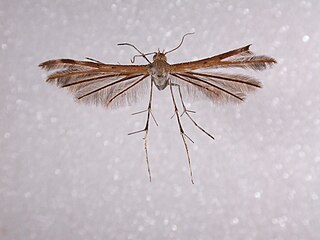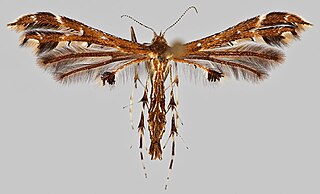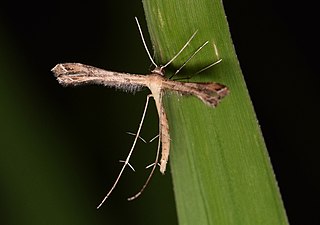
The Pterophoridae or plume moths are a family of Lepidoptera with unusually modified wings. Though they belong to the Apoditrysia like the larger moths and the butterflies, unlike these they are tiny and were formerly included among the assemblage called "microlepidoptera".

Pterophorus pentadactyla, commonly known as the white plume moth, is a moth in the family Pterophoridae. It is found in the West Palearctic including North Africa and Europe. The wingspan is 26–34 mm (1.0–1.3 in). It is uniformly white, with the hind wing pair divided in three feathery plumes and the front pair in another two. The moths fly from June to August. The larvae feed on bindweed.

Gillmeria ochrodactyla is a moth of the family Pterophoridae found in Asia and Europe. It was first described by the Austrian entomologists, Michael Denis & Ignaz Schiffermüller in 1775.

Stenoptilia pterodactyla, the brown plume is a moth of the family Pterophoroidea. It is found in Europe, North America, Anatolia, Iran and China. It was first described by the Swedish taxonomist, Carl Linnaeus in 1761.

Amblyptilia acanthadactyla, also known as the beautiful plume, is a moth of the family Pterophoroidea found in across the Palearctic including Europe. The species was first described by the German entomologist, Jacob Hübner in 1813.

Megalorhipida leucodactyla is a species of moth of the family Pterophoridae that has a pantropical distribution.

Oxyptilus ericetorum is a moth of the family Pterophoridae. It is found in most of Europe, east to Siberia.

The geranium plume moth is a moth of the family Pterophoridae. It is found in western Africa, Madagascar, India, Sri Lanka, Thailand, Japan, the New Hebrides and Central and South America, as well as Australia, where it has been recorded from Cape York to central New South Wales. It is found in the United States, where it has been recorded from Florida, as well as Mississippi. It is also present in the Kermadec Islands of New Zealand.

Stenoptilodes taprobanes is a moth of the family Pterophoridae. This species has a pantropical distribution, which extends into subtropical areas.

Pterophorus albidus is a moth of the family Pterophoridae. It is distributed in Africa, south and south-east Asia, including New Guinea and Australia, as well as Japan (Kyushu) and the Ryukyu Islands.
Nippoptilia cinctipedalis is a moth of the family Pterophoridae. It is found in Australia, Korea, Japan (Kyushu), China, Micronesia, the Republic of Palau and Vietnam.

Amblyptilia punctidactyla, also known as the Brindled Plume, is a moth of the family Pterophoridae found across the Palearctic. The species was first described by the English entomologist, Adrian Hardy Haworth in 1811.
Nippoptilia issikii is a moth of the family Pterophoridae, that is known from Japan (Hokkaido), and Korea and China.

Hellinsia distinctus is a moth of the family Pterophoridae that is found from Europe to India, Korea, Japan, China and Russia. Within Europe, it is found from Germany and the Benelux east to Poland, Slovakia, Hungary and Romania, from Italy north to Fennoscandia, and in Greece, Estonia, Latvia and northern and central Russia.
Leptodeuterocopus neales is a moth of the family Pterophoridae that is known from Costa Rica, Ecuador, Guatemala, Mexico, Suriname, Paraguay, Peru and Venezuela. It has recently been recorded from Florida.

Crombrugghia distans, also known as the Breckland plume is a moth of the family Pterophoridae found in Africa, Asia and Europe. It was first described by Philipp Christoph Zeller in 1847.

Crombrugghia tristis is a moth of the family Pterophoridae. It is found in most of Europe, except the Benelux, Great Britain, Ireland and Scandinavia. It is also known from southern Siberia, Asia Minor and central Asia. The habitat consists of sandy areas overgrown with Hieracium.

Hellinsia inquinatus is a moth of the family Pterophoridae. It is found in North America, including Florida, Mississippi, Oklahoma, Tennessee, Maryland, Alabama, Texas, Missouri, Colorado and Arizona. It has also been recorded from Hispaniola, Mexico, Puerto Rico and St. Thomas Island.

Oidaematophorus eupatorii, the eupatorium plume moth or Joe Pye plume moth, is a moth of the family Pterophoridae. It is found in North America, including Florida, Mississippi, Iowa, New York, California and Vancouver Island. It is also known from Mexico, Guatemala and Panama.

Hellinsia ochracealis is a moth of the family Pterophoridae. It is found in Brazil, Nicaragua, Colombia and Peru.


















